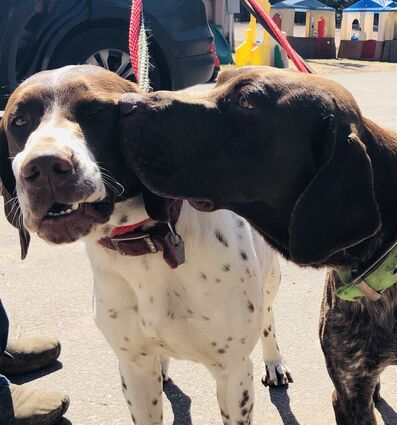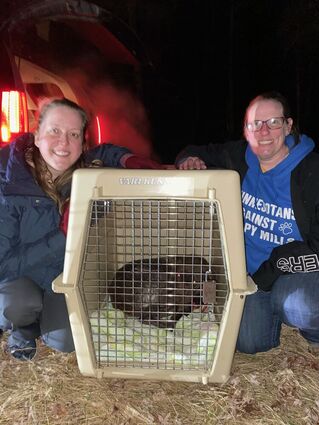Pet Advice: Lost dogs need special treatment
April 30, 2021
"If I yell for my dog, I know they will come to me." We hear people say this all the time, but unfortunately 90 percent of the time it does not work, and it actually makes the dog run farther away. This behavior exhibited by lost dogs has absolutely nothing to do with their training, background, or love for their owners. Survival mode is a primal instinct for lost dogs. All they are thinking about is food, water, and shelter. Survival mode is what keeps lost dogs alive in a plethora of elements, but it also keeps them from coming to their owners right away as well, so don't take it personally.
We caution people they are no longer searching for "their" dog, but they are now looking for a dog that is "lost." Once they have reached survival mode, dogs view all humans, including their owners, as predators and feel they must avoid them to stay alive.
Thankfully, this is a temporary state of being for lost dogs, and they return to their earlier personalities once they are captured and back with their owners. In fact, this is one reason why we emphatically stress the use of scent items (owner's unwashed clothing, dog's blanket, sheets the owner has slept on) to help guide your dog's nose back to you. Often, once the lost dog gets close enough to get a good whiff of its owner, the survival mode is abated and the "light bulb" moment occurs where it again recognizes the safety of its owner's loving arms.
Survival mode was very apparent with my most recent case involving Luna and Remington, two German Shorthair Pointers that got loose in the Walmart parking lot in Cloquet while they were being rehomed on April 3. Both were instantly jolted into pure survival mode. They continued to run frantically for 13 days throughout Cloquet and even made a three-day appearance on the FDL Reservation. We were getting minute-by-minute, day-by-day sightings of the terrified duo, but there was no way anybody could hand-catch them.
Our wonderful pet village did a fantastic job of alerting us to the dogs' locations via social media, but we had to strongly caution well-meaning people to NOT yell at, call to, chase, grab or even make eye contact with them. Direct eye contact with a dog (especially a lost dog) is a sign of fight or flight. We always instruct people to get low onto the ground, to not make eye contact, and absolutely NO yelling (whether it's your own lost dog or any lost dog). You want to make yourself the least threatening as you can. People often wonder why we will not post lost dogs' names or specific sighting information, and this is exactly why.
Thankfully, I was able to humanely trap both dogs Friday, April 16, approximately four hours apart, bringing their terrifying journey safely to an end. Luna was trapped around midnight and Remington was trapped just after 4 a.m. But this was after I had trap-conditioned them for a week. We needed them to find the food we were leaving for them and, thankfully, they did. It required lots of patience, liquid smoke, Worcestershire sauce and, as always, rotisserie chicken.
Writer Amy Addy is a case manager with The Retrievers lost dog team. She says if your dog does go missing, please reach out to both Missing Pets in the Northland at https://www.facebook.com/CloquetLostPets and The Retrievers lost dog team at https://theretrievers.org or https://www.facebook.com/TheRetrieversLostDogTeam.
*******
How to act with a lost dog
Here are behaviors to avoid, and behaviors that establish you are not a threat to a lost dog.
Behaviors to avoid:
Facing the dog directly
Speaking directly to the dog
Making direct eye contact
Advancing directly toward the dog, even slowly
Making sudden or quick movements
Speaking loudly/yelling at or making any kind of loud noise
Continuing to stand tall over the dog
Displaying any stress or panicked feelings of your own, or impatience
Behaviors to establish that you are non-threatening to the dog:
Sit or otherwise put your body low toward the ground, closer to the dog's level (remembering to avoid the above behaviors)
Lie down on the ground and whine softly
Yawn, lick your lips, cough or sniff, loudly enough to be heard
Slowly turn your head and/or your body away from the dog
Do normal things that demonstrate self-interest as opposed to an interest in the dog, such as applying lip balm
Behaviors to lure the dog toward you, after establishing that you are not a threat:
Do gently call attention to yourself if the dog doesn't see you
Crinkle a bag, which might sound like a snack bag, containing smelly bait such as cooked and dried cut-up hot dog or rotisserie chicken
Eat something while making "yummy, yummy" noises, dropping bits of the food around onto the floor; a crumbly muffin is a good example
Slowly toss treats to the dog, slowly; if possible, over the shoulder and while facing away
When you have more than one person to participate in the luring behavior you can:
Play frisbee or catch with each other (props required)
Speak conversationally to each other, showing a lack of interest in the dog
When you have another dog to participate in the luring (preferably a dog that is bonded with the lost dog), lavish attention on the other dog (e.g., overly praise, treat or play fetch with the other dog).



